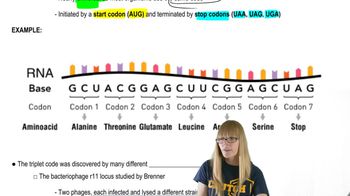Table of contents
- 1. Introduction to Genetics51m
- 2. Mendel's Laws of Inheritance3h 37m
- 3. Extensions to Mendelian Inheritance2h 41m
- 4. Genetic Mapping and Linkage2h 28m
- 5. Genetics of Bacteria and Viruses1h 21m
- 6. Chromosomal Variation1h 48m
- 7. DNA and Chromosome Structure56m
- 8. DNA Replication1h 10m
- 9. Mitosis and Meiosis1h 34m
- 10. Transcription1h 0m
- 11. Translation58m
- 12. Gene Regulation in Prokaryotes1h 19m
- 13. Gene Regulation in Eukaryotes44m
- 14. Genetic Control of Development44m
- 15. Genomes and Genomics1h 50m
- 16. Transposable Elements47m
- 17. Mutation, Repair, and Recombination1h 6m
- 18. Molecular Genetic Tools19m
- 19. Cancer Genetics29m
- 20. Quantitative Genetics1h 26m
- 21. Population Genetics50m
- 22. Evolutionary Genetics29m
11. Translation
The Genetic Code
Problem 29g
Textbook Question
Shown here are the amino acid sequences of the wild-type and three mutant forms of a short protein.
___________________________________________________
Wild-type: Met-Trp-Tyr-Arg-Gly-Ser-Pro-Thr
Mutant 1: Met-Trp
Mutant 2: Met-Trp-His-Arg-Gly-Ser-Pro-Thr
Mutant 3: Met-Cys-Ile-Val-Val-Val-Gln-His _
Use this information to answer the following questions:
Of the first eight wild-type triplets, which, if any, can you determine specifically from an analysis of the mutant proteins? In each case, explain why or why not.
 Verified step by step guidance
Verified step by step guidance1
Identify the wild-type amino acid sequence and the sequences of the three mutants.
Compare the wild-type sequence with each mutant sequence to identify changes.
For Mutant 1, note that the sequence is truncated after 'Met-Trp', suggesting a possible early stop codon or deletion.
For Mutant 2, observe that 'Tyr' is replaced by 'His', indicating a point mutation in the codon for 'Tyr'.
For Mutant 3, the sequence is completely different, suggesting a frameshift mutation or a large insertion/deletion.
Recommended similar problem, with video answer:
 Verified Solution
Verified SolutionThis video solution was recommended by our tutors as helpful for the problem above
Video duration:
29sPlay a video:
Was this helpful?
Key Concepts
Here are the essential concepts you must grasp in order to answer the question correctly.
Amino Acid Sequence
The amino acid sequence of a protein is the order of amino acids in the polypeptide chain, which determines the protein's structure and function. Each amino acid is encoded by a specific triplet of nucleotides in DNA, known as a codon. Analyzing the differences in sequences between wild-type and mutant proteins can reveal which amino acids are altered, providing insights into the effects of mutations on protein function.
Recommended video:
Guided course

Sequencing Difficulties
Mutations and Their Effects
Mutations are changes in the DNA sequence that can lead to alterations in the amino acid sequence of proteins. These changes can be classified as missense, nonsense, or frameshift mutations, each affecting protein function differently. Understanding the type of mutation present in the mutant proteins helps in determining which specific amino acids in the wild-type sequence can be inferred from the analysis of the mutants.
Recommended video:
Guided course

Maternal Effect
Comparative Analysis of Protein Sequences
Comparative analysis involves examining the amino acid sequences of different protein variants to identify similarities and differences. By comparing the wild-type sequence with those of the mutants, one can deduce which amino acids remain unchanged and which have been altered. This analysis is crucial for determining the specific triplets that can be inferred from the mutant sequences, as it highlights the impact of mutations on the overall protein structure.
Recommended video:
Guided course

Proteins

 11:43m
11:43mWatch next
Master The Genetic Code with a bite sized video explanation from Kylia Goodner
Start learningRelated Videos
Related Practice


